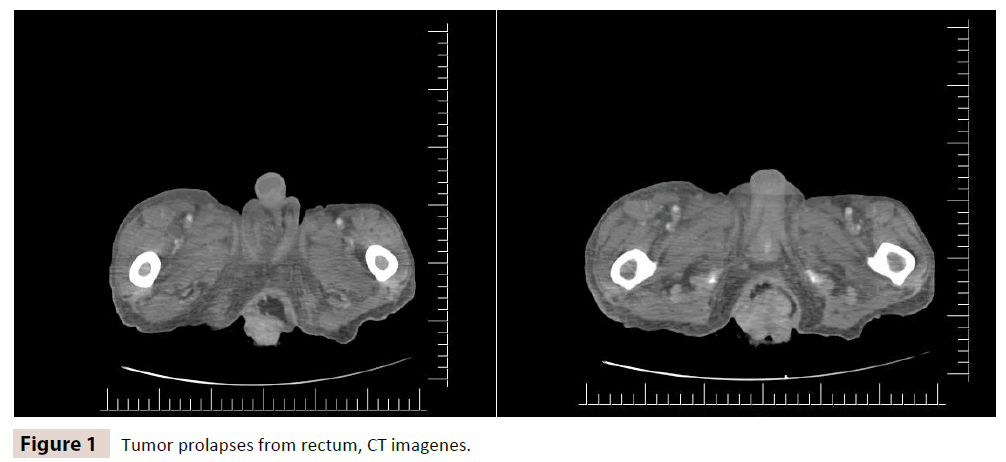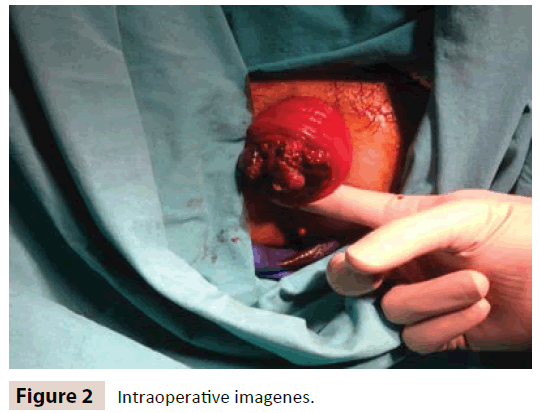Rectosigmoidal Tumor Prolapsed Through Anal Canal: A Case Report
Erdinç Çetinkaya, Bekir Bulut, Savas Baba, Cem Emir Güldogan and Bülent Cavit Yüksel
DOI10.4172/2472-1891.100021
Erdinç Çetinkaya*, Bekir Bulut, SavaÃÆââ¬Â¦Ãâà ¸ Baba, Cem Emir GüldoÃÆââ¬Å¾Ãâà ¸an and Bülent Cavit Yüksel
Ankara Numune Education and Research Hospital,Department of Colorectal Surgery, Turkey
- *Corresponding Author:
- Erdinc Cetinkaya
Department of Colorectal Surgery, General Surgery
Ankara Numune Education and Research Hospital, Sihhiye 06100 Ankara, Turkey
Tel: +905052918788
E-mail: drerdinccetinkaya@gmail.com
Received date: January 25, 2016; Accepted date: February 16, 2016; Published date: February 23, 2016
Citation: Çetinkaya E, Bulut B, Baba S, et al. Rectosigmoidal Tumor Prolapsed Through Anal Canal: A Case Report. Int J Dig Dis. 2016, 2:1. doi:10.4172/2472-1891.100021
Abstract
Rectal prolapsus is the protrusion of either the rectal mucosa or the entire wall of the rectum through the anal canal. Constipation, weakness of the pelvic floor, previous anorectal surgery are among the etiological reasons. Although concomitant presence of colorectal polyp and rectal ulcer is common, concomitant presence of a colorectal tumor is very rare. Our case was a 68 years old patient diagnosed with metastatic colon cancer. While the administration of neoadjuvant chemotherapy, he applied with an irreducible, bleeding rectal tumor prolapsus. His general condition was deteriorated and he had pneumonia. We performed Altemeier’s procedure. Post-operative pathological analysis revealed a moderately differentiated adenocarcinoma with negative surgical margins.
Introduction
The etiological cause of rectal prolapsus, which is defined as the protrusion of either the rectal mucosa or the entire wall of the rectum through the anal canal, is not fully clarified [1]. Although constipation is considered as the main etiological cause, long sigmoid colon, weakness of the pelvic floor, weak internal sphincter and amorphous anus, pelvic floor defects; and concomitant neurological disorders, previous surgical interventions and chronic cough may also play a role in the etiology [2]. Co-existence of a colorectal tumor is very rare and there are very limited number of studies focusing on this subject [3]. This co-existence is very important regarding the choice of the surgical technique. We reported this case, because the protrusion of a rectal tumor from the anal canal is a rare clinical presentation.
Case
68 years old male patient, who did not have any concomitant disorder and previous operation history, was diagnosed with rectal cancer in May, 2013. As further investigation pointed at metastatic rectal cancer, the patient was referred to the oncology department and chemotherapy was planned. After the second chemotherapy cycle; as the patient has applied for the third cycle, the chemotherapy has been canceled because of his deteriorated general condition (Figure 1). The patient applied because of rectal prolapsus and hematochezia to our hospital’s emergency unit and as the examination revealed a prolapsed rectal tumor, an urgent Computerized Tomography (CT) was performed. CT displayed, “prolapsed segments, with sigmoid colon invaginated to the rectum, diffuse wall thickening (17 mm in the thickest region) and co-existence of invaginated segment with the posterior wall of the rectum at the anal level” (Figure 2).
With the existing findings, the patient was referred to the Colorectal SurgeryOutpatient Department. Because of the deteriorated general condition and dyspnea, we performed Altemeier’s procedure under emergency conditions with general anesthesia due to the diagnosis of prolapsed, actively bleeding rectal tumor. After the operation, rectal examination revealed that the anastomosis was approx. 7-8 cm to the anal aperture. Vital findings of the patient were stabilized in the post-operative period. In the second day of the operation, fecal and wind passing started and in the 4th day, the patient was orally fed.
Pathological analysis showed moderately differentiated adenocarcinoma. The surgical margin of the 14 cm long resection material was negative. The resected material did not contain any lymph node.
Discussion
Rectal prolapsus can be defined as the protrusion of either the rectum or the rectum with the sigmoid colon through the anal canal. The prevalence in the population is 1/1000. Furthermore, rectal prolapsus can be encountered in the patients with changed bowel habit [4]. The change of the anatomic structure as a result of prolapsed rectum through the anal canal is encountered together with the change of bowel habit and previous surgical operations increase the risk of rectal prolapsus [5]. Constipation and increased intraabdominal pressure may provoke the development of the rectal prolapsus [6]. Yamazaki et al. stated that constipation developed as a result of sigmoid colon cancer predisposes rectal prolapsus [3]. They concluded that the early-onset rectal prolapsus may be induced by colorectal cancer and it may be a symptom of colorectal cancer. They also suggested that the patients with sudden rectal prolapsus should be examined for colorectal cancer. In our case, we observed that the sudden rectal prolapsus is linked to the rectal tumor. There are abdominal and perineal approach techniques and one of these techniques is chosen regarding the general condition and the performance of the patient and the anesthesia type. In our case, as the general condition was deteriorated and general anesthesia was not applicable, epidural anesthesia was used. In a study conducted by Rashid et al., 70 patients with rectal prolapsus was enrolled into the study beside a control group [2]. In this study, the incidence of the rectosigmoid cancer was 5,7 % among the patients with rectal prolapsus and the comparison of the rectal prolapsus patients with the control group showed that the risk of colorectal cancer is 4.2 times higher in the patients with prolapsus.
Conclusion
In conclusion, rectal prolapsus may develop due to the tumor, besides other benign causes or it may increase the incidence of colorectal cancer. Therefore, in patients applying with a rectal prolapsus, a detailed medical history should be taken and after the rectal examination, rectosigmoidoscopy should be performed. Thus, concomitant malignancy will be not overlooked. Surgical procedure and the type of the anesthesia can be determined according to the clinical characteristics of the patient. In patients with deteriorated general condition, who cannot tolerate general anesthesia, epidural anesthesia and perineal surgical approach techniques can be used.
References
- Karahasanoglu T, Hamzaoglu I, Baca B, Ve Ark (2007) Rektal Prolapsus Tedavisinde Laparoskopik Cerrahi. Kolon Rektum Hast Derg 17: 186-190
- Rashid Z, Basson MD (1996) Association of rectal prolapse with colorectal cancer. Surgery 119: 51-55.
- Yamazaki T, Sakai Y, Sekine Y, Nihei K, Hatakeyama K, et al. (1999) Sigmoid colon cancer presenting as complete rectal prolapse: report of a case. Surg Today 29: 266-267.
- Agachan F, Pfeifer J, Wexner SD (1996) Defecography and proctography: results of 744 patients. Dis Colon Rectum 899-905.
- Lisa KJ, Lin YJ, Orkun BA (1997) The best operation for rectal prolapse. Surg Clin North Am 77: 49-70.
- Karanjia ND, Rutter KRP (1994) Solitary rectal ulcer and rectal prolapse. Curr Pract Surg 6: 59-64.
Open Access Journals
- Aquaculture & Veterinary Science
- Chemistry & Chemical Sciences
- Clinical Sciences
- Engineering
- General Science
- Genetics & Molecular Biology
- Health Care & Nursing
- Immunology & Microbiology
- Materials Science
- Mathematics & Physics
- Medical Sciences
- Neurology & Psychiatry
- Oncology & Cancer Science
- Pharmaceutical Sciences


